Guide ON SWEET POTATO farming in kenya
Introduction to Sweet Potato Farming in Kenya
Sweet potatoes (Ipomoea batatas) have become one of the most important crops in Kenya. They are a staple food source, especially for rural and urban poor populations, due to their resilience and adaptability. They are drought-tolerant and can grow in a variety of climates, making them an essential crop for food security and income generation.
Kenya produces approximately 871,000 tons of sweet potatoes annually, significantly contributing to the agricultural sector and rural economy. Farmers prefer sweet potatoes due to their low production costs, quick maturity, and high nutritional value—particularly in orange-fleshed varieties, which are rich in Vitamin A and help combat malnutrition.
Growing Conditions for Sweet Potato Farming
Sweet potatoes are highly adaptable but thrive best under specific environmental conditions:
1. Climate and Temperature
- Optimal temperatures: 21°C to 28°C
- Cannot tolerate frost and struggle at temperatures below 10°C
- Need 750mm to 1,500mm of rainfall per year
- High altitudes (above 2,100m) may slow growth
2. Soil Requirements
- Prefers well-drained, slightly acidic soils (pH 4.5 - 7.0)
- Ideal soils: Sandy loam or loamy clay, which retain moisture while allowing proper aeration
- Deep plowing (20-30cm) improves root penetration and drainage
- Ridge or mound planting is recommended to prevent waterlogging
3. Altitude Considerations
- Can grow at altitudes of up to 2,500m
- High altitudes: Longer maturity periods, reduced growth rates
- Low altitudes: Faster maturity but may require drought-resistant varieties
Planting and Cultivation Practices
Sweet potatoes are propagated using vine cuttings (slips) rather than seeds or tubers.
1. Land Preparation
- Clear the land of weeds and debris
- Deep tillage (20-30cm) ensures aeration
- Create ridges or mounds (30-45cm high, 1m apart) to improve drainage
- Incorporate organic matter (compost or manure) for better fertility
2. Planting
- Use healthy vine cuttings (30cm long with 3-4 nodes)
- Plant cuttings diagonally on ridges or mounds at a 45-degree angle
- Space cuttings 30cm apart within rows that are 1m apart
- Water well immediately after planting and consistently for the first few days
3. Fertilization
- Apply NPK 17:17:17 fertilizer at 200kg/ha
- Essential nutrients:
- Nitrogen (60-80 kg/ha) - Enhances leaf growth
- Phosphorus (60-80 kg/ha) - Supports root development
- Potassium (40-70 kg/ha) - Improves tuber formation
- Side-dress with fertilizer 4-6 weeks after planting but avoid excessive nitrogen to prevent excessive vine growth at the expense of tubers
4. Pest, Disease, and Weed Control
Pests
- Sweet potato weevil (Cylas formicarius) - Controlled by crop rotation and proper sanitation
- Whiteflies - Managed through insecticidal sprays and companion planting
- Aphids and caterpillars - Controlled with organic pesticides and early intervention
Diseases
- Sweet potato virus disease (SPVD) - Avoid using infected planting material
- Root rot and fungal infections - Maintain proper drainage and crop rotation
- Leaf spot diseases - Use fungicides and resistant varieties
Weed Control
- Crucial during the first 6-8 weeks
- Use mulching and manual weeding to suppress weed growth
Harvesting and Post-Harvest Handling
- Maturity period: 3-6 months, depending on variety and climate
- Signs of maturity:
- Yellowing leaves
- Cracks forming in the soil
- Harvesting methods:
- Cut vines before digging
- Use hoes or mechanical tools carefully to avoid damaging tubers
Post-Harvest Handling
- Curing: Store in a warm, humid place (30°C, 85-90% humidity) for 4-7 days to heal minor wounds and improve shelf life
- Storage:
- Dry, cool areas prevent rotting
- Can be stored in underground pits, ventilated crates, or controlled environments
Sweet Potato Varieties in Kenya
| Variety | Key Characteristics | Ideal Regions |
|---|---|---|
| Kabode | High Vitamin A, warm climates | Western, Nyanza, Coast |
| Vitaa | Beta-carotene rich, sweet taste | Central, Western |
| Beauregard | Adaptable, high commercial value | Most regions |
| SPK004 (KALRO) | Disease-resistant, high yield | Medium altitude |
| KEMB 36 | Pest and disease-resistant | All major zones |
| Tainung | Large tubers, high market demand | Eastern, Central |
Yield and Profitability Analysis
- Typical yield: 4-12 tons per acre
- Well-managed farms: 15-25 tons per acre
- Potential earnings: KSh 150,000-300,000 per acre
- Production costs per acre: KSh 120,000-200,000
- Market price per kg: KSh 15-45
Cost Management Strategies
- Bulk purchasing of inputs reduces costs
- Efficient labor management minimizes expenses
- Proper storage techniques reduce post-harvest losses
- Contract farming guarantees better prices
Opportunities and Challenges in Sweet Potato Farming
Opportunities
- Growing local and international demand
- Value addition opportunities (processing into flour, chips, or baby food)
- Government and NGO support (e.g., KALRO research and extension services)
- Potential for cooperative farming to improve bargaining power
Challenges
- Infrastructure limitations (poor roads and storage facilities)
- Pests and diseases reducing yields
- Market volatility and exploitation by middlemen
- Limited knowledge and extension services
Conclusion
Sweet potato farming is a highly profitable and food-secure agricultural venture in Kenya. With proper farming practices, pest management, and marketing strategies, farmers can maximize yields and income.
To succeed:
- Select high-yielding, disease-resistant varieties
- Follow best agricultural practices
- Invest in proper post-harvest handling
- Take advantage of market linkages and value addition
- Stay updated with modern techniques
With increasing demand and better farming support, sweet potato farming remains a promising and sustainable agribusiness opportunity for Kenyan farmers. 🚜


